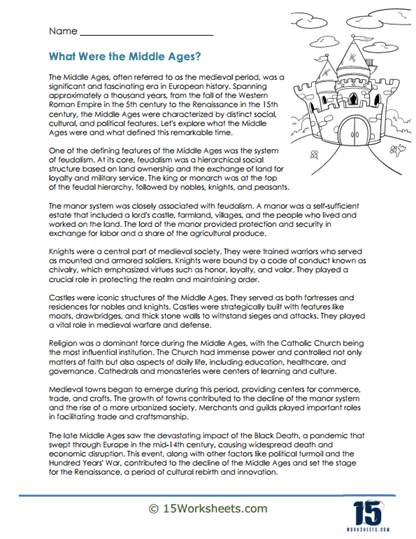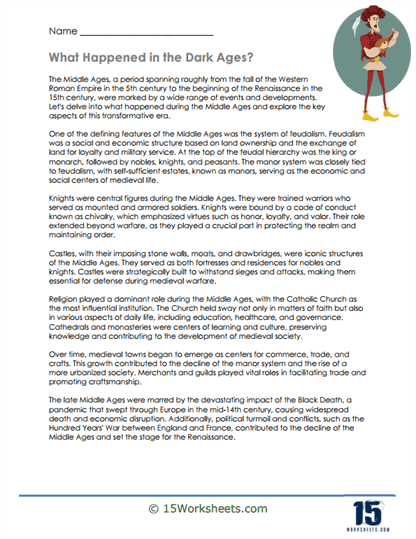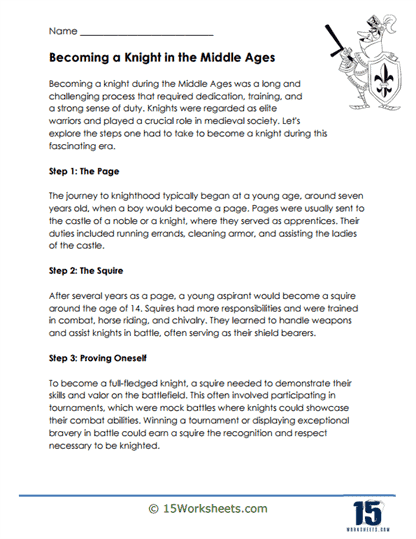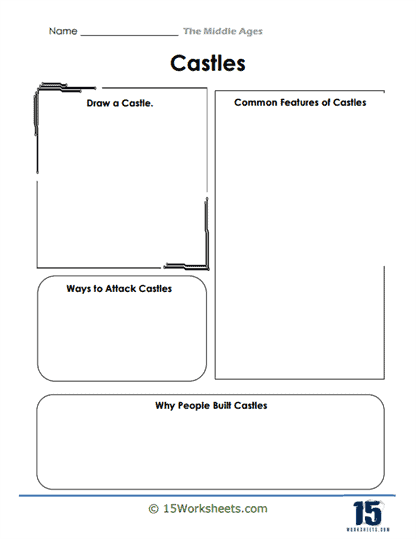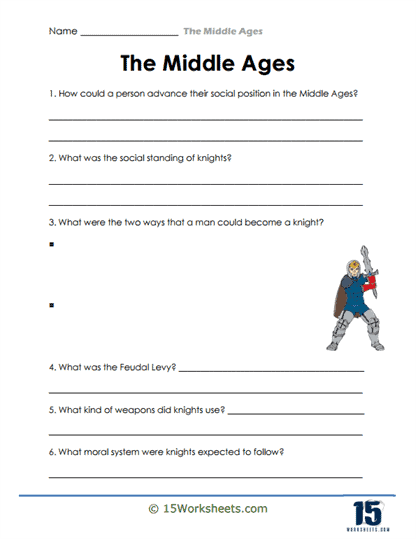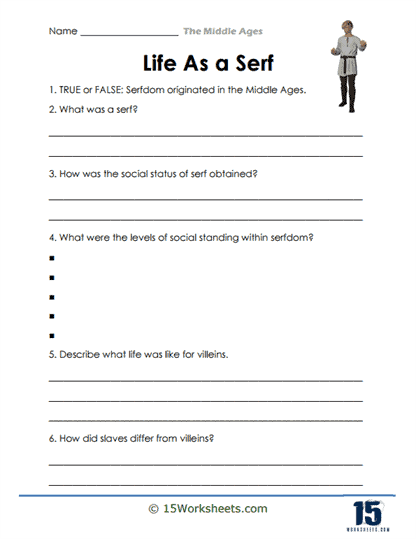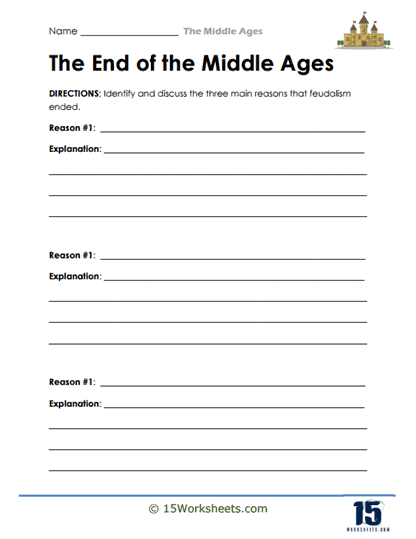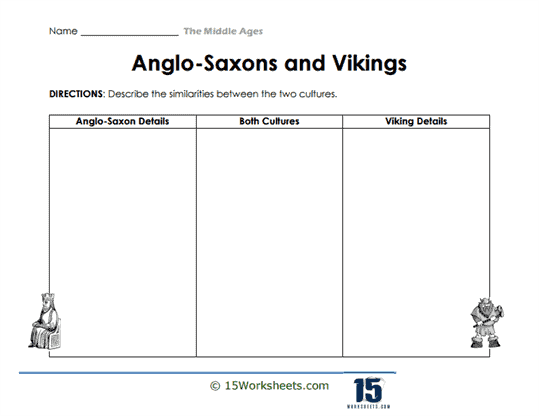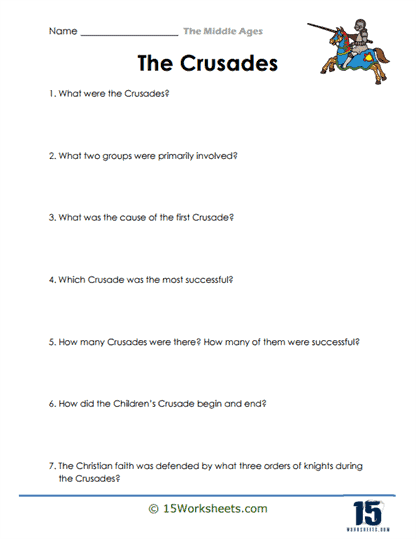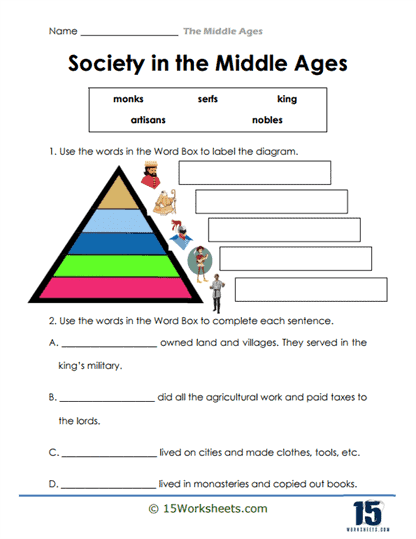Middle Ages Worksheets
About These 15 Worksheets
These worksheets were designed to help students learn about the period in European history known as the Middle Ages or Medieval period, spanning approximately from the 5th to the late 15th century. This era, characterized by its unique blend of cultural, social, political, and economic elements, plays a crucial role in understanding the foundations of modern Western civilization. These worksheets come in various forms and include a range of exercises to cater to different learning styles and objectives. Learning about the Middle Ages is significant for students, as it offers valuable insights into historical processes, cultural developments, and the evolution of societal structures that have shaped the modern world.
Middle Ages worksheets offer a diverse range of exercises that not only enhance students’ knowledge about this pivotal period in history but also develop their analytical, critical thinking, and empathetic skills. Learning about the Middle Ages is crucial in understanding the evolution of modern societies, appreciating the cultural heritage of the Western world, and developing a nuanced perspective on historical and contemporary issues. Through these studies, students gain valuable insights into the complexities of human societies, the progression of knowledge, and the enduring impact of historical events and decisions.
Types of Exercises
Historical Timelines and Events – These exercises focus on important events and eras within the Middle Ages, such as the fall of the Roman Empire, the Viking Age, the Crusades, and the Hundred Years’ War. Timelines help students visually understand the sequence of events and how they interconnect. Students are often asked to label or create maps showing the shifting borders of kingdoms, routes of significant historical events like the Crusades, or the spread of the Black Death. These exercises enhance geographical knowledge and illustrate the impact of historical events on different regions.
Biographies – Worksheets may include reading and writing activities about key figures of the Middle Ages, like Charlemagne, Joan of Arc, Richard the Lionheart, or Eleanor of Aquitaine. Understanding these figures helps students grasp the influence of individual leaders on history. Exercises that explore the daily life of different social classes, such as peasants, nobles, and clergy, including their living conditions, occupations, and social roles. Role-playing activities can be particularly effective in this context.
Literature and Language – Activities related to Middle Ages literature, including works like “The Canterbury Tales” or “Beowulf.” Students might translate Old or Middle English texts, or write their own stories or poems in a medieval style. Students might analyze and recreate medieval art forms, such as illuminated manuscripts, tapestries, or Gothic architecture. These exercises help students appreciate the artistic legacy of the period.
Science and Technology – Exploring medieval advancements in fields like astronomy, agriculture, and warfare. This may include building models of medieval inventions or studying the works of scholars like Roger Bacon.
Economic and Trade Activities – Understanding the medieval economy, including the feudal system, guilds, and the rise of trade networks. Activities may include simulations of medieval marketplaces or trade routes. Exercises that encourage students to critically analyze historical sources, such as medieval texts or artifacts, and to understand the perspectives and biases of these sources.
The Importance of the Learning About the Middle Ages
The importance of learning about the Middle Ages extends far beyond mere academic interest; it is crucial for understanding the foundations of modern Western civilization and our current societal structures. This period, often characterized by its unique blend of feudalism, religious influence, and burgeoning nation-states, offers rich insights into the evolution of social, political, and cultural norms that shape our world today.
Studying the Middle Ages is essential for developing a comprehensive understanding of historical foundations. This era laid the groundwork for many of the institutions, legal systems, and cultural practices that are central to contemporary society. By exploring the development of these systems during the Middle Ages, students gain a deeper appreciation for the complexity and longevity of these foundational structures. Additionally, the period’s influence on Western culture is profound, with its art, literature, and philosophy significantly shaping modern Western thought and aesthetics. Knowledge of medieval works and ideas enriches students’ cultural literacy and provides a broader context for understanding contemporary literary and artistic expressions.
The social and political structures that emerged during the Middle Ages, such as the feudal system and the rise of nation-states, are key to understanding the development of modern governance and societal organization. The role of the Church, in particular, highlights the interplay between religion and politics, a theme that remains relevant in current global discussions. Moreover, the Middle Ages challenges students to think critically about historical narratives. It presents an opportunity to recognize the multifaceted nature of history, where events are shaped by a diversity of perspectives and complex social dynamics.
Scientific and technological advancements of the Middle Ages, often underrepresented in discussions about historical progress, were nonetheless significant. By studying these developments, students learn to appreciate the cumulative and often nonlinear nature of scientific knowledge and technological innovation. The period was also marked by extensive global interactions, as seen in the Crusades, the spread of religions, and burgeoning trade networks. These interactions offer early examples of globalization, providing insights into how different cultures have historically interacted and influenced each other.
The moral and ethical dilemmas of the Middle Ages, from questions of feudal loyalty to the ethics of crusading, have enduring relevance. Engaging with these issues helps students develop moral and ethical reasoning skills, allowing them to better navigate the complex ethical landscapes of the modern world. On a more personal level, understanding the Middle Ages can also have direct relevance for students. It helps them to see the origins of many modern cultural practices, traditions, and beliefs, thereby connecting their personal experiences to a broader historical narrative.
Learning about the Middle Ages fosters empathy and a deeper understanding of the human experience. By exploring the lives of diverse individuals from kings to peasants, students gain insight into the varied experiences of people in the past. This understanding helps cultivate a sense of empathy and connection to those who lived centuries ago, bridging the gap between the present and the past.
In essence, studying the Middle Ages is not just about learning historical facts; it’s about understanding the evolution of societies, appreciating our cultural heritage, and developing a nuanced perspective on historical and contemporary issues. It equips students with the knowledge and skills to understand and appreciate the complexities of human societies, the progression of knowledge, and the enduring impact of historical events and decisions on our modern world.

